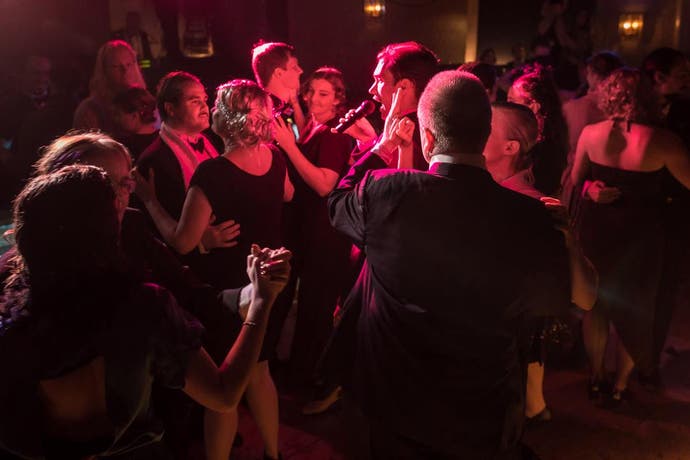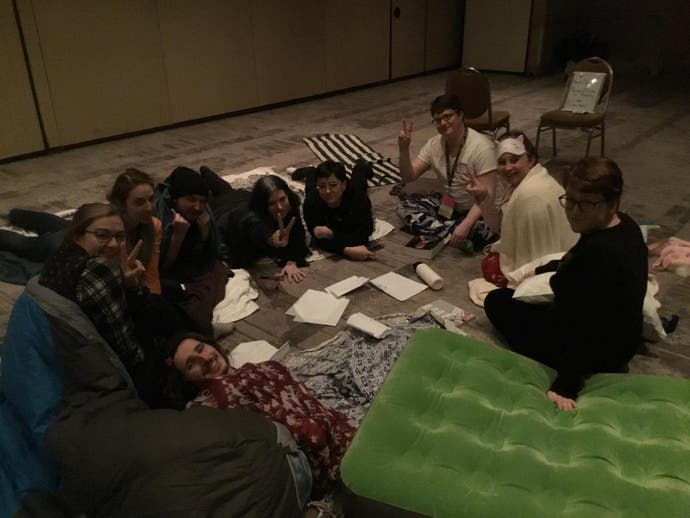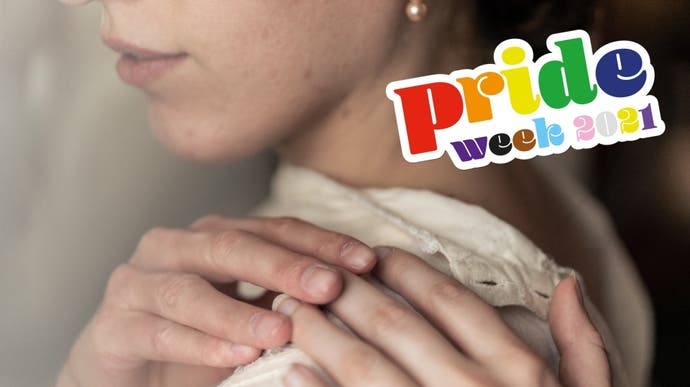Finding Queerness in Larp
An introduction to the LGBT+ live-action role-playing scene.
Hello! All this week Eurogamer is celebrating Pride with a series of stories examining the confluence of LGBT+ communities and play in its many different forms, from video games and tabletop games through to live-action role-play. Today, Evan offers an introduction to the ever-expanding queer larping scene.
Live-action role-play (larp) is often associated with people in fantasy outfits swinging foam swords, or gothed-out college students pretending they're vampires on weekend nights. But in a modern society saturated in genre fiction and also weirdly restrictive on what we might do with our bodies, larp is also much cooler than you think. This global entertainment medium transcends mere "entertainment": it helps us try out new identities and maybe keep a few bits of what we've tried. Those of us who larp must also engage with queerness and, might I add, everyone should at least try larping.
At the 2019 Intercon S convention, "the premiere multi-genre LARP convention in the world", a friend came up to me, dripping with sweat. "The room was full," they said in disbelief. "Just wall-to-wall queer larpers. There are so many of us now." My friend was referring to a meetup for LGBTQ-identifying larpers at a North American convention that, only a short time ago, required special content warnings for larp events containing "queer romance."
In the 1990s Nordic larp scene, a running joke was that there were only four out gay or lesbian larpers among them, each from the respective countries that constituted the scene back then: Sweden, Norway, Denmark, and Finland. By contrast, at the 2018 Knutpunkt Nordic larp conference held in Lund, Sweden, there were so many LGBTQ-identifying larpers that whole separate queer men/non-binary and women/non-binary room parties took place (and were full), as well as several talks, events, and group chats.
Where did all these queer people come from, and why do they now larp?

In the past 40 years, larp has gone from a medium of numerous niche subcultures around the world to a household word, and being out as queer in the larp scene has recently and rapidly become the social norm.
Media portrayals ranging from the 2003 Ogre Battle "Lightning Bolt!" video to glossy coverage of the popular College of Wizardry magic-school larp introduced the medium and subculture to mainstream audiences. One could get the impression that larp is part cosplay, part "let's pretend!", and part renaissance faire. Larp designers now apply their talents to a range of derivative forms, many of which you no doubt recognise: escape rooms, immersive theatre, virtual reality chat, live-action online games (LAOGs), and social media role-play. A recent strain in journalistic usage of the term "larp" connects it with politically vocal individuals dressing up as and pretending to be something they're not.
But one thing is for certain about larp in the current cultural moment: the active global scene is irreducibly and unapologetically queer. At the same time, however, nothing is settled on that front in terms of form, content, or community.

If larp is a technology and medium of artistic expression, then we can claim that this medium has evolved considerably over the last several decades. Larps of all sizes have the capacity to address serious topics. For the international queer community, a core topic is HIV/AIDS, and since 2011 there has been a larp that directly addresses it.
One thing is for certain about larp in the current cultural moment: the active global scene is irreducibly and unapologetically queer. At the same time, however, nothing is settled on that front in terms of form, content, or community.
Just A Little Lovin' (JALL) is a five-day larp event about the gay scene in New York from 1982 to 1984 written by Tor Kjetil Edland and Hanne Grasmo. Players experience the hedonism of the early 1980s as well as the shock and grief as the AIDS pandemic ravaged the community and brought that partying to an end. "We wanted to tell this story as a larp both to give the participants an intellectual and emotional connection to it, but also to tell a universal queer story about desire, fear of death and friendship," the creators say.

In the Nordic larp community, JALL is considered one of the best games ever, and international players, queer and otherwise, flock to every run. Erik Winther Paisley explains: "I got to stand as a statue and lie half-dressed, makeup smeared, and look at myself in that big, gorgeous mirror in the dressing room. It was bizarre and I don't know how to square that image of myself with what I otherwise am." Many JALL players seek the positive-negative experience of being nestled in a queer community, losing and mourning members of that community, and then coming together as a collective to form their own ACT UP and other anti-AIDS organisations in-game. It gives them the ability to play something risky and vulnerable in an incredibly safe space. Queerness now has a larp home.
Nevertheless, we should not reduce all queer larp to Just A Little Lovin'. Standard genre larps also function as sites where players can explore their sexuality and gender identity, or express a more authentic version of themselves through a fictional persona. People find the freedom to put on makeup or play an elf princess, or explore a relationship written on their character sheet that they might not otherwise try.
Jaakko Stenros and Tanja Sihvonen write that "queer players want to be included in larps in the same way as anyone else - but not in a way that erases their histories, identities, and lived experiences." When you can create embodied fictions in your free time, why create new spaces where you are oppressed, when you can create spaces of exploration and liberation?

Embodied fictions such as larp and LAOGs continue to expand in popularity. Spenser Starke's Alice Is Missing is a texting-based larp hybrid that allows players silent, suspenseful queer play. Julia B. Ellingboe and Kat Jones' The Sleepover simulates teenagers staying at a summer camp and safely pushing their characters' sexual boundaries. Players now have the tools and mechanics of consent to actively play on such themes, rather than smuggle them into their monthly starship-crew or fantasy larp. Transparency and consent are the design tools that let us take ever more risks in queer larping. I look forward to the many new creations to come.
